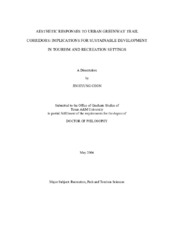| dc.contributor.advisor | Shafer, C. Scott | |
| dc.creator | Chon, Jin Hyung | |
| dc.date.accessioned | 2005-08-29T14:37:08Z | |
| dc.date.available | 2005-08-29T14:37:08Z | |
| dc.date.created | 2003-05 | |
| dc.date.issued | 2005-08-29 | |
| dc.identifier.uri | https://hdl.handle.net/1969.1/2262 | |
| dc.description.abstract | Urban greenway trails are emerging as potential tourist attractions in cities and are well recognized for their recreation opportunities in general. The study presented an opportunity to expand the scope of aesthetic response research into the realm of urban greenway trails. The concept of likability (Nasar, 1998) was used as a guiding concept in the study. In order to gather data for the study, a web-based virtual tour was developed and implemented. Treatments were assigned to 6 groups that viewed two urban greenway trail corridors. Each trail had three treatments including the existing trail condition, a manipulated trail condition, and a reverse in direction of the existing trail condition. Analyses were conducted to 1) identify dimensions of aesthetic responses, 2) examine relationships between cognitive evaluation, affective response, trail characteristics, and likability, and 3) evaluate specific greenway trail characteristics and their relationships to the trail experience. Results indicated five aesthetic dimensions of the greenway trail corridors. The cognitive dimensions were maintenance, distinctiveness, and naturalness and the affective dimensions were pleasantness and arousal. Pleasantness and distinctiveness were the strongest predictors of likability in urban greenway trails. In terms of greenway trail characteristics, six of eight specific characteristics had predictive value in relation to how inviting the virtual trail was to the viewer. Finally, several greenway trail characteristics had significant influences on human perception and the likability of trail environments. This study proposed a new way of conceptualizing likability and a model of relationships leading to likability. One of the major implications of this study is to identify a way to improve physical conditions of greenway corridors in urban areas based on aesthetic responses. The study also implied that greenways can encompass natural or man-made features and can be managed and developed as a tourist attraction while providing local opportunities in cities. Aesthetic quality influences perceived quality of life and sense of well-being. Findings of the study can help enhance the aesthetic quality of the greenway trails that can contribute to sustainable development in various tourism and recreation settings. | en |
| dc.format.extent | 3290948 bytes | en |
| dc.format.medium | electronic | en |
| dc.format.mimetype | application/pdf | |
| dc.language.iso | en_US | |
| dc.publisher | Texas A&M University | |
| dc.subject | aesthetic response | en |
| dc.subject | urban greenway trail | en |
| dc.subject | sustainable development | en |
| dc.subject | tourism | en |
| dc.subject | recreation | en |
| dc.subject | likability | en |
| dc.subject | quality of life | en |
| dc.subject | well-being | en |
| dc.title | Aesthetic responses to urban greenway trail corridors: Implications for sustainable development in tourism and recreation settings | en |
| dc.type | Book | en |
| dc.type | Thesis | en |
| thesis.degree.department | Recreation, Park and Tourism Sciences | en |
| thesis.degree.discipline | Recreation, Park and Tourism Sciences | en |
| thesis.degree.grantor | Texas A&M University | en |
| thesis.degree.name | Doctor of Philosophy | en |
| thesis.degree.level | Doctoral | en |
| dc.contributor.committeeMember | Watt, Carson | |
| dc.contributor.committeeMember | Ellis, Christopher D. | |
| dc.contributor.committeeMember | Petrick, James F. | |
| dc.type.genre | Electronic Dissertation | en |
| dc.type.material | text | en |
| dc.format.digitalOrigin | born digital | en |


